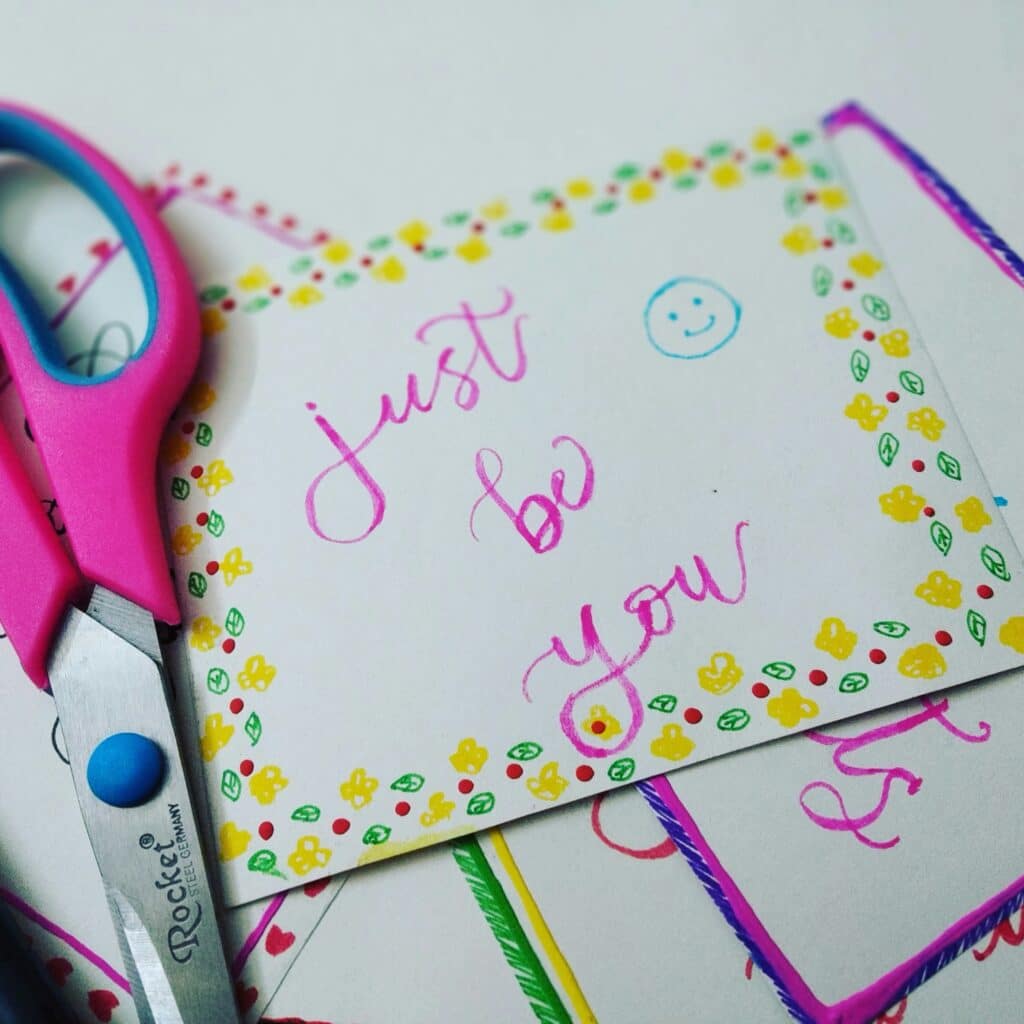Making time for yourself as a caring professional is one of the best things you can do to recharge and lower your stress. However, if you found your way to this blog post, you might face some challenges with that. Perhaps the concept of a “hobby” is a foreign language to you. Or, maybe you don’t know what to do with yourself when you get a rare free moment, so you end up scrolling your phone. And after this “break”, you still feel frazzled. Maybe you even feel like you wasted your time. Enter: the self care menu.
A self care menu is a way to have recharging, ready-to-go stress relief and wellness options for moments when you can’t even be bothered to make a decision. You have a plan to handle whatever you need at the moment. You’ve got proactive ways to keep yourself functioning at your best.
Let’s back up a bit, though. You might be thinking: “What does self care even mean?” Or, maybe self care brings up a mental image of bubble baths, spa retreats, and manicures. While these activities can be self care, they aren’t the only options. And, sometimes they’re not what you need at all. So, let’s break it down.
What is self care?
Self care is just that – taking care of yourself. It can be taking care of your physical self, your mental self, or any other parts of you that need maintenance (social, spiritual, financial, and so on). It’s something that requires deliberate time and effort, but it’s worth it to keep you feeling your best.

What self care is not:
An indulgence, selfishness, or a waste of time. It also doesn’t have to take a lot of time! There are good reasons to take lots of time for yourself, but that’s not always realistic. This is why it’s a good idea to create a self care menu to help yourself find the right choice for self care at any time.
Self care also does not mean that when you put yourself first, you put others last. In fact, doing self care means you can give more to others. We all know the saying: “you can’t pour from an empty cup.” Self care is refilling that cup.
Sometimes, self care can be fun things like spa days or bubble baths or movie days. And sometimes, it’s not fun at all. Sometimes self care means doing things that you don’t want to do. Self care can also be going to the doctor for a much-delayed physical. It can be choosing to go to therapy. It can be carving out time for physical activity. It can be adding more vegetables to your diet.
The practice of self care involves checking in with your body, mind, and wellness and seeing what you need. Then, you act accordingly.

Why is self care important?
Self care can do many things for you, but here are a few big ones:
- Lowers stress
- Improves mood and lowers the severity of mental health symptoms
- Prevents burnout
- Improves your physical health
- Increases motivation and focus
- Raises energy levels
- Improves your ability to care for others (if you’re here as a caring professional, this one’s for you. I’m sure you need to hear it more – caring for yourself is not selfish, and in fact makes you better at your job. You also deserve it, regardless of how it affects your productivity).
To get the most out of your self care and ensure a range of benefits, you’ll want to include options for all the different types of wellness on your self care menu. Working on all areas of wellness will also help you decrease your stress in the long run.
What are the types of self care?
According to the national Substance Abuse and Mental Health Services Administration (SAMHSA), there are eight major dimensions of wellness. They include:
- Emotional
- Environmental
- Financial
- Intellectual
- Occupational
- Physical
- Social
- Spiritual
Let’s cover some ways to care for each dimension of your wellness. Keep in mind that some of the examples can work for multiple dimensions. These examples can be helpful if you want to get more bang for your self care buck.
Emotional
- Go to therapy
- Spend time doing a creative hobby
- Start a journal
- Have a good cry
- Meditate
- Spend time with a friend who “gets” you
Environmental
- Clean your house
- Get an air purifier to reduce allergies
- Use sunscreen
- Get your home checked for toxins like mold
- Add plants to your office
- Switch to non-toxic household products

Financial
- Create a budget
- Go on a spending freeze
- Contribute to a 401k
- Read “de-influencing” blogs
- Set aside $5 a day for a year
- Audit your subscriptions and remove ones you don’t use
Intellectual
- Read or write
- Listen to music
- Learn a new language
- Do some word puzzles
- Visit somewhere new
- Listen to an educational podcast
Occupational
- Learn a new work-related skill
- Get a certification
- Update your resume
- Apply for different jobs
- Say no to draining tasks
- Organize the documents on your computer
Physical
- Movement
- Rest
- Eat more veggies
- Start a skincare routine
- Go to the doctor
- Commit to drinking less
Social
- Call a friend
- Get out of the house
- Go to a book club
- Attend a support group
- Co-work when you normally work from home
- Attend a local event

Spiritual
Whether you’re religious or non-religious, spiritual wellness can also mean connecting with your values and your identity.
- Help someone in need
- Breathwork
- Prayer
- Meet with a spiritual community
- Read a book that aligns with your identity
- Donate time or money to a charity
How do I know what I need to include in my self care menu?
You can start by filling out a wellness wheel. This practice involves ranking your satisfaction with each of the eight areas of wellness on a scale from 1-10, with 1 being not satisfied and 10 being completely satisfied. Choose the areas of your wellness that need the most TLC to focus on for your self care menu.
Build your own self care menu with this template
For each dimension of wellness that needs improvement, choose a 5-minute, a 30-minute, and a 1+ hour strategy. You can also write down any specific needs you have, regardless of what wellness category they fall into.
Here are some example strategies for each area of wellness:
Emotional
- 5-minute option: Vent your feelings into a phone voice memo
- 30-minute option: Spend some time doing one of your creative hobbies (knitting, art, building LEGOs, etc)
- 1+ hour option: Watch a heartfelt movie
Environmental
- 5-minute option: Install a carbon monoxide detector
- 30-minute option: Change out the air filter(s) in your home
- 1+ hour option: Check your household products for hazardous chemicals and safely store and secure any that exist in your home
Financial
- 5-minute option: Check your credit score
- 30-minute option: Do an audit of last month’s spending and notice any patterns
- 1+ hour option: Set up a budget
Intellectual
- 5-minute option: Learn a new word in a foreign language
- 30-minute option: Watch a documentary episode
- 1+ hour option: Enroll in a pottery class
Occupational
- 5-minute option: Check LinkedIn for updates in your career network
- 30-minute option: Refresh your resume
- 1+ hour option: Complete a course for continuing education credit
Physical
- 5-minute option: Do some gentle stretches
- 30-minute option: Prepare healthy snacks for the week
- 1+ hour option: Complete a cancer screening
Social
- 5-minute option: Answer a couple texts you’ve forgotten to respond to
- 30-minute option: Call a close friend
- 1+ hour option: Spend a weekend sight-seeing in a local city with friends
Spiritual
- 5-minute option: Practice box breathing: breathe in for 4 counts, hold for 4 counts, breathe out for 4 counts, hold for 4 counts
- 30-minute option: Listen to a podcast that aligns with your values
- 1+ hour option: Spend a day volunteering to clean up your neighborhood
Let’s go through an example self care menu:
Here’s a blank template for you to save and fill out:
Tips for following through with self care
Make a plan and stick to it
Be specific about when you’re going to dedicate time to your self care menu options. You may need to plan ahead, or set up times in your calendar so you don’t get double-booked. Set reminders on your phone, or use other reminder and accountability systems that work for you.
Communicate your need for self care to your loved ones
This is especially important if you have people in your life who impact your ability to set aside time to care for yourself. If you have kids, you can even find some self care activities that involve them (although I really do encourage you to take time away for yourself – this is an emergency tactic).

Find an accountability buddy
If you know someone who’s also committed to improving their wellness, ask them to share their plans with you and do the same with them. Set up a regular check in time – this can be once a week, once a month, or however often you need.
If you can’t find an accountability buddy, or if you have a hard time following through with your plans, you might benefit from working with a health coach. I specialize in helping educators and service professionals, so I can help you with the specific barriers you face. If you’re ready to get started, you can book a call with me here.







Leave a Reply